A Numerical Investigation of the Effects of Groove Texture on the Dynamics of a Water-Lubricated Bearing–Rotor System
Abstract
1. Introduction
2. Mathematical Models
2.1. Governing Equations
2.2. Dynamic Characteristics
2.3. Bearing–Rotor Dynamic Model
2.3.1. Stability Analysis
2.3.2. Unbalance Response Analysis
2.4. Calculation Process
3. Validation of the Calculation Process
4. Results and Discussion
4.1. Dynamic Characteristics of Groove-Textured WLHB
4.1.1. Effects of Rotary Speed
4.1.2. Effects of Eccentricity Ratio
4.1.3. Effects of Groove Depth
4.1.4. Effects of Groove Width
4.1.5. Effect of Groove Length Ratio
4.2. Stability of Groove-Textured, Water-Lubricated Bearing–Rotor System
4.2.1. Effects of Rotary Speed
4.2.2. Effects of Eccentricity Ratio
4.2.3. Effects of Groove Depth
4.2.4. Effect of Groove Width
4.2.5. Effect of Groove Length
4.3. Unbalance Response of Groove-Textured, Water-Lubricated Bearing–Rotor System
4.3.1. Effect of Rotary Speed
4.3.2. Effect of Eccentricity Ratio
4.3.3. Effect of Groove Depth
4.3.4. Effect of Groove Width
4.3.5. Effect of Groove Length Ratio
5. Conclusions
- (1)
- The groove texture can enhance the direct stiffness along the load direction and weaken the stiffness in the orthogonal direction , especially at greater rotational speed, smaller eccentricity ratio, and a shallower and longer groove. When a bearing with a groove depth of 10 μm, a groove length of 1 and width of 1.1 degrees is working at 20,000 rpm and a 0.1 eccentricity ratio, the stiffness can be improved by 98.4%. With the increased width of the groove, the dynamic coefficients show an increase–decrease–increase trend or decrease–increase–decrease trend; with increased eccentricity ratio and rotary speed, the groove texture has little effect on the direct damping coefficients but improves the coupled damping coefficients; for most of the cases, the damping coefficients can be improved with increased groove depth; with the increased width of the groove, the damping coefficients increase slightly. These complex variations may be attributed to the combination of cavitation and flow vortex.
- (2)
- The groove texture can play a more obvious positive effect on the stability of a rotor supported by WLHBs with shallow and longer grooves at a greater rotary speed and smaller eccentricity ratio; there exists an optimum groove width to achieve the largest critical mass. When the length ratio is 1, the stability is improved by about 20.5% with groove widths of 0.1 degrees and 1.1 degrees at a rotary speed of 20,000 rpm. The main reason for this phenomenon is due to the improvement of direct stiffness and direct damping coefficient in the direction of the applied load, as well as the weakening of whirling motion due to the existence of a groove texture with proper parameter settings.
- (3)
- As for the unbalance response, the groove texture is beneficial for the dynamics of the rotor at a small eccentricity ratio and great rotary speed. A shallower and longer groove can decrease the unbalance response more apparently; there exists an optimal groove width to decrease the amplitude of the unbalance response. The most significant decrease in groove texture on unbalance response exists at a rotary speed of 20,000 rpm, groove depth of 10 μm, groove length ratio of 1, groove width of 0.1 degree and 1.1 degrees. However, it should be noted that the improvement of the groove texture on the unbalance response of the bearing–rotor system is not as significant as that on the dynamic characteristics of the bearing. As a result, in actual application, considering the manufacturing cost of texture, the effects of texture should be comprehensively considered.
Author Contributions
Funding
Data Availability Statement
Conflicts of Interest
Abbreviations
| WLHB | Water-lubricated hydrodynamic bearing | ||
| UDF | User Defined Function | ||
| DLC | Difference of the load capacity method | ||
| Nomenclature | |||
| k | Turbulent kinetic energy | Cxx, Cyy, Cxy, Cyx. | Damping coefficients |
| Radial clearance | External body force | ||
| Critical mass | Evaporation coefficient | ||
| Density | Kxx and Kyy; Kxy and Kyx | Stiffness | |
| ε | Turbulent dissipation rate | Length of the bearing | |
| Mst | Non-dimension critical mass | ||
| λl | Groove length ratio | P | Static pressure |
| Viscosity | Pv | Vaporization pressure | |
| Stress tensor | RB, | bubble radius | |
| Nucleation site volume fraction | Re and Rc | mass transfer source terms | |
| Velocity vector | Rotary speed | ||
| Gravitational body force | |||
References
- Armentrout, R.W.; He, M.; Haykin, T.; Reed, A.E. Analysis of turbulence and convective inertia in a water-lubricated tilting-pad journal bearing using conventional and CFD approaches. Tribol. Trans. 2017, 60, 1129–1147. [Google Scholar] [CrossRef]
- Mallya, R.; Shenoy, S.B.; Pai, R. Steady state characteristics of misaligned multiple axial groove water-lubricated journal bearing. Proc. Inst. Mech. Eng. Part J J. Eng. Tribol. 2015, 229, 712–722. [Google Scholar] [CrossRef]
- Tauviqirrahman, M.; Jamari, J.; Bagir, M.; Caesarendra, W.; Paryanto, P. Elastohydrodynamic behavior analysis on water-lubricated journal bearing: A study of acoustic and tribological performance based on CFD-FSI approach. J. Braz. Soc. Mech. Sci. Eng. 2022, 44, 1. [Google Scholar] [CrossRef]
- Litwin, W.; Wasilczuk, M.; Wodtke, M.; Olszewski, A. The influence of polymer bearing material and lubricating grooves layout on wear of journal bearings lubricated with contaminated water. Tribol. Int. 2023, 179, 108159. [Google Scholar] [CrossRef]
- Xiang, G.; Wang, J.; Han, Y.; Yang, T.; Dai, H.; Yao, B.; Zhou, C.; Wang, L. Investigation on the nonlinear dynamic behaviors of water-lubricated bearings considering mixed thermoelastohydrodynamic performances. Mech. Syst. Signal Process. 2022, 169, 108627. [Google Scholar] [CrossRef]
- Liang, X.; Yan, X.; Ouyang, W.; Liu, Z. Experimental research on tribological and vibration performance of water-lubricated hydrodynamic thrust bearings used in marine shaft-less rim driven thrusters. Wear 2019, 426, 778–791. [Google Scholar] [CrossRef]
- Feng, H.; Jiang, S.; Shang-Guan, Y. Three-dimensional computational fluid dynamic analysis of high-speed water-lubricated hydrodynamic journal bearing with groove texture considering turbulence. Proc. Inst. Mech. Eng. Part J J. Eng. Tribol. 2021, 235, 2272–2286. [Google Scholar] [CrossRef]
- Feng, H.; Peng, L. Numerical analysis of water-lubricated thrust bearing with groove texture considering turbulence and cavitation. Ind. Lubr. Tribol. 2018, 70, 1127–1136. [Google Scholar] [CrossRef]
- Hao, X.; Sun, H.; Wang, L.; Ali, Q.; Li, L.; He, N. Fabrication of micro-texture on cylindrical inner surface and its effect on the stability of hybrid bearing. Int. J. Adv. Manuf. Technol. 2020, 109, 1671–1680. [Google Scholar] [CrossRef]
- Hu, D.; Guo, Z.; Xie, X.; Yuan, C. Effect of spherical-convex surface texture on tribological performance of water-lubricated bearing. Tribol. Int. 2019, 134, 341–351. [Google Scholar] [CrossRef]
- Wang, X.; Kato, K.; Adachi, K.; Aizawa, K. Loads carrying capacity map for the surface texture design of SiC thrust bearing sliding in water. Tribol. Int. 2003, 36, 189–197. [Google Scholar] [CrossRef]
- Xiang, G.; Yang, T.; Guo, J.; Wang, J.; Liu, B.; Chen, S. Optimization transient wear and contact performances of water-lubricated bearings under fluid-solid-thermal coupling condition using profile modification. Wear 2022, 502, 204379. [Google Scholar] [CrossRef]
- Zou, H.; Yan, S.; Shen, T.; Wang, H.; Li, Y.; Chen, J.; Meng, Y.; Men, S.; Zhang, Z.; Sui, T. Efficiency of surface texturing in the reducing of wear for tests starting with initial point contact. Wear 2021, 482, 203957. [Google Scholar] [CrossRef]
- Chen, L.; Li, R.; Xie, F.; Wang, Y. Load-bearing capacity research in wet clutches with surface texture. Measurement 2019, 142, 96–104. [Google Scholar] [CrossRef]
- Usman, A.; Park, C.W. Numerical optimization of surface texture for improved tribological performance of journal bearing at varying operating conditions. Ind. Lubr. Tribol. 2018, 70, 1608–1618. [Google Scholar] [CrossRef]
- Xie, Z.; Zhang, Y.; Zhou, J.; Zhu, W. Theoretical and experimental research on the micro interface lubrication regime of water lubricated bearing. Mech. Syst. Signal Process. 2021, 151, 107422. [Google Scholar] [CrossRef]
- de Kraker, A.; van Ostayen, R.A.J.; van Beek, A.; Rixen, D.J. A. Multiscale Method Modeling Surface Texture Effects. J. Tribol. 2006, 129, 221–230. [Google Scholar] [CrossRef]
- He, T.; Xie, Z.; Ke, Z.; Dai, L.; Liu, Y.; Ma, C.; Jiao, J. Theoretical Study on the Dynamic Characteristics of Marine Stern Bearing Considering Cavitation and Bending Deformation Effects of the Shaft. Lubricants 2022, 10, 242. [Google Scholar] [CrossRef]
- Sharma, S.; Jamwal, G.; Awasthi, R.K. Dynamic and stability performance improvement of the hydrodynamic bearing by using triangular-shaped textures. Proc. Inst. Mech. Eng. Part J J. Eng. Tribol. 2020, 234, 1436–1451. [Google Scholar] [CrossRef]
- Singh, N.; Awasthi, R. Influence of surface textures on the dynamic stability and performance parameters of hydrodynamic two-lobe journal bearings. Proc. Inst. Mech. Eng. Part J J. Eng. Tribol. 2022, 236, 1589–1602. [Google Scholar] [CrossRef]
- Jiang, Y.; Gao, Y.; An, Q. Dynamic analysis of the rotor supported by journal bearing with micro-spherical surface texturing. Proc. Inst. Mech. Eng. Part K J. Multi-Body Dyn. 2014, 228, 355–365. [Google Scholar] [CrossRef]
- Niu, Y.; Hao, X.; Xia, A.; Wang, L.; Liu, Q.; Li, L.; He, N. Effects of textured surfaces on the properties of hydrodynamic bearing. Int. J. Adv. Manuf. Technol. 2022, 118, 1589–1596. [Google Scholar] [CrossRef]
- Smolík, L.; Rendl, J.; Omasta, M.; Byrtus, M.; Šperka, P.; Polach, P.; Hartl, M.; Hajžman, M. Comprehensive analysis of fluid-film instability in journal bearings with mechanically indented textures. J. Sound Vib. 2023, 546, 117454. [Google Scholar] [CrossRef]
- Manshoor, B.; Jaat, M.; Izzuddin, Z.; Amir, K. CFD analysis of thin film lubricated journal bearing. Procedia Eng. 2013, 68, 56–62. [Google Scholar] [CrossRef]
- Gao, G.; Yin, Z.; Jiang, D.; Zhang, X. Numerical analysis of plain journal bearing under hydrodynamic lubrication by water. Tribol. Int. 2014, 75, 31–38. [Google Scholar] [CrossRef]
- Wu, N.; Guo, H.; Yang, S.; Zhang, S. Thermal effect on stability and minimum oil film thickness of a deep/shallow pockets conical bearing. Ind. Lubr. Tribol. 2020, 72, 1251–1257. [Google Scholar] [CrossRef]
- Durany, J.; Pereira, J.; Varas, F. Dynamical stability of journal-bearing devices through numerical simulation of thermohydrodynamic models. Tribol. Int. 2010, 43, 1703–1718. [Google Scholar] [CrossRef]
- Hou, Z.Q.; Xiong, W.L.; Yang, X.B.; Yuan, J.L. Study on dynamic characteristics of a hydrostatic and hydrodynamic journal bearings for small diameter grinding spindle. Adv. Mater. Res. 2012, 497, 99–104. [Google Scholar] [CrossRef]
- Li, Q.; Zhang, S.; Ma, L.; Xu, W.; Zheng, S. Stiffness and damping coefficients for journal bearing using the 3D transient flow calculation. J. Mech. Sci. Technol. 2017, 31, 2083–2091. [Google Scholar] [CrossRef]
- Zhang, X.; Yin, Z.; Gao, G.; Li, Z. Determination of stiffness coefficients of hydrodynamic water-lubricated plain journal bearings. Tribol. Int. 2015, 85, 37–47. [Google Scholar] [CrossRef]

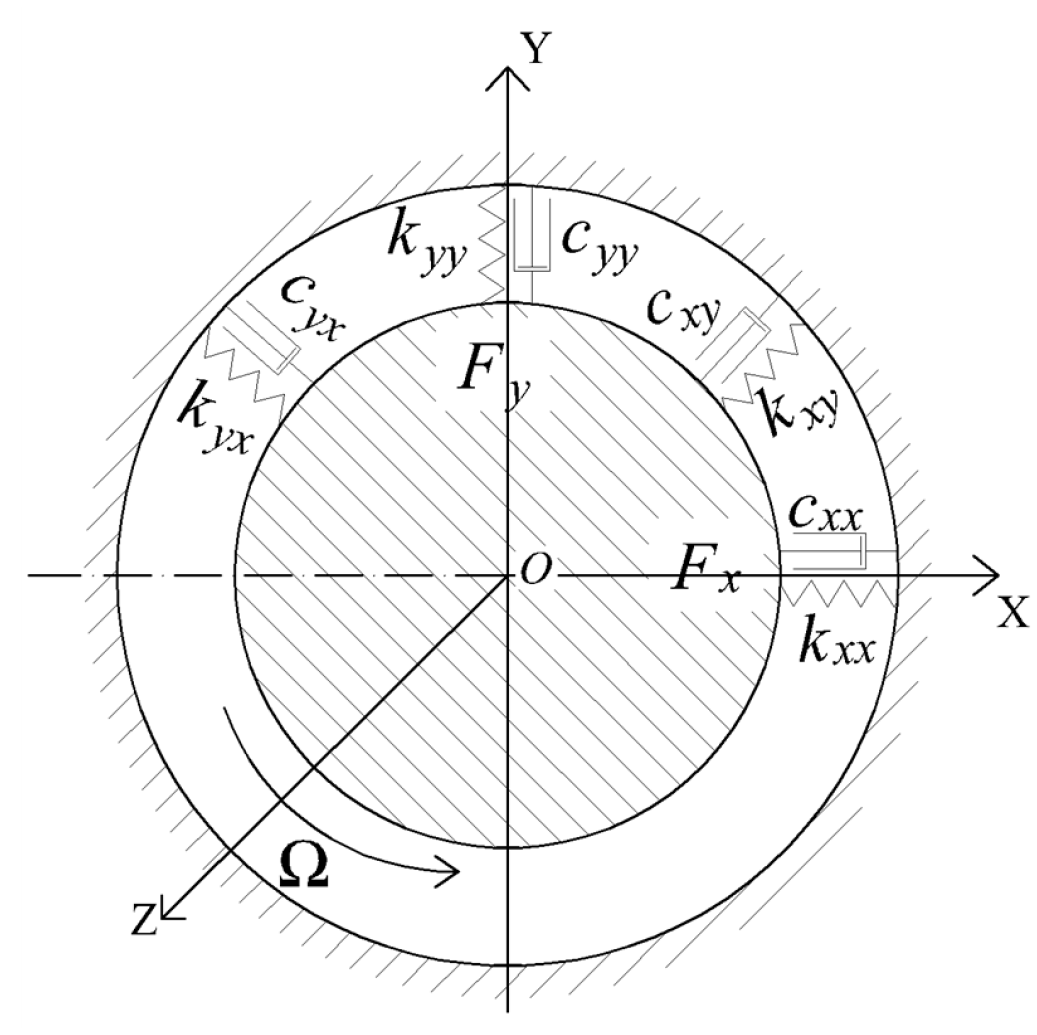

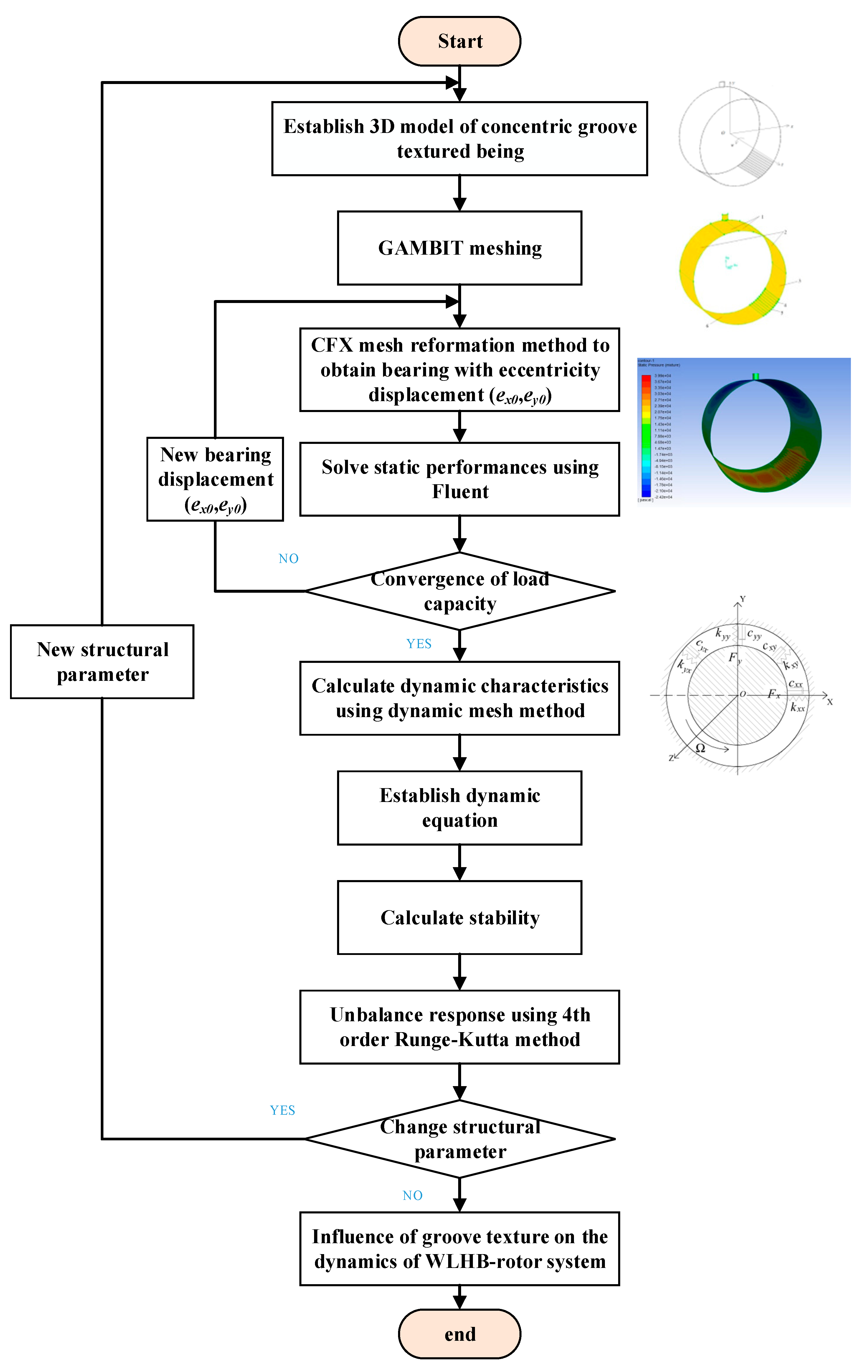
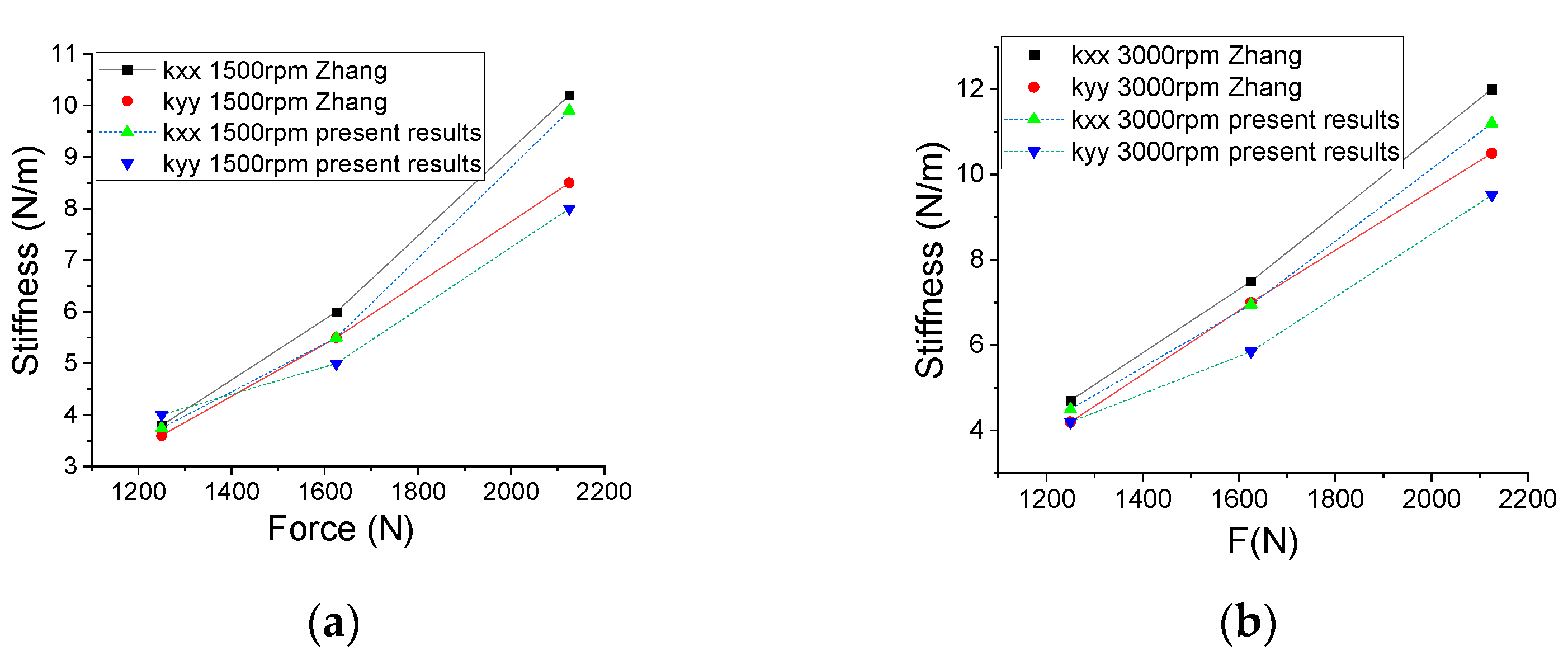
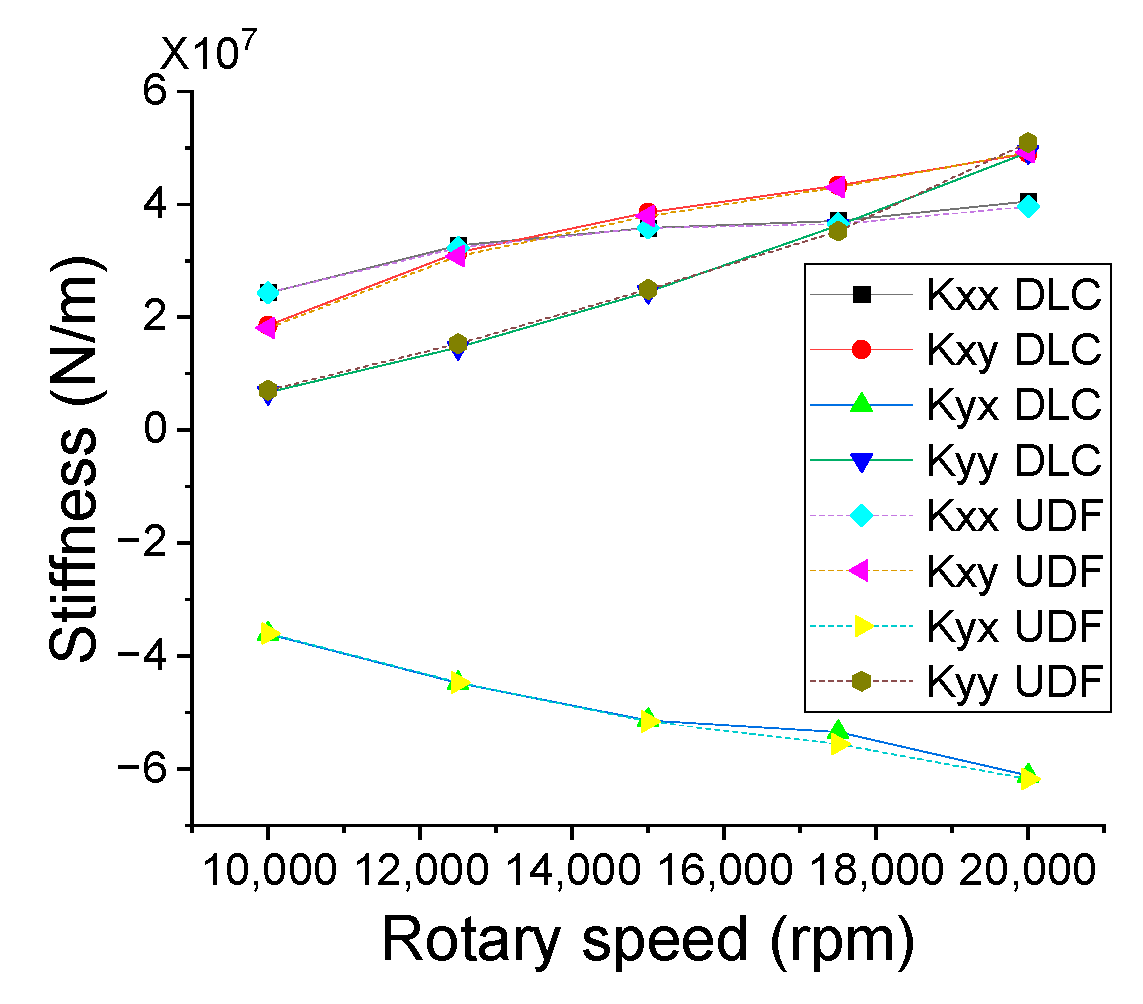
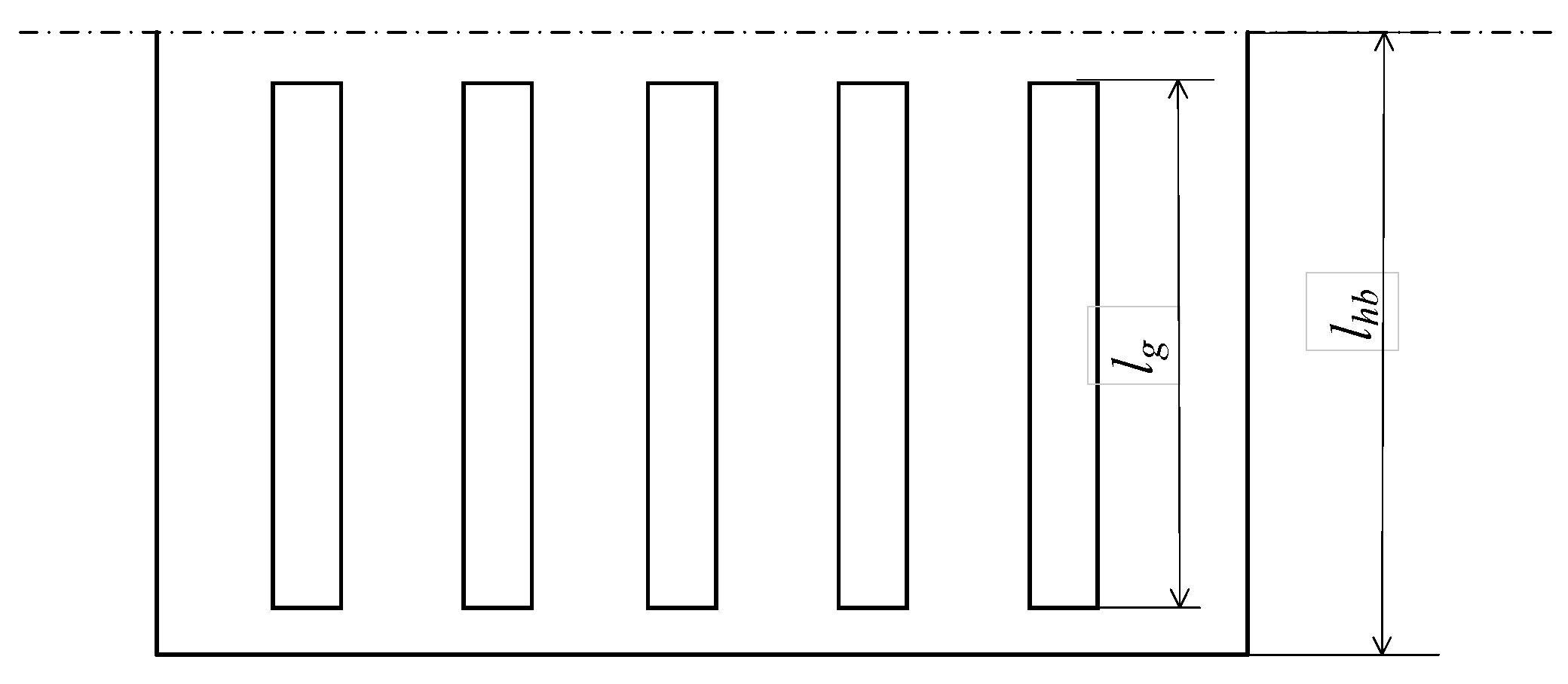
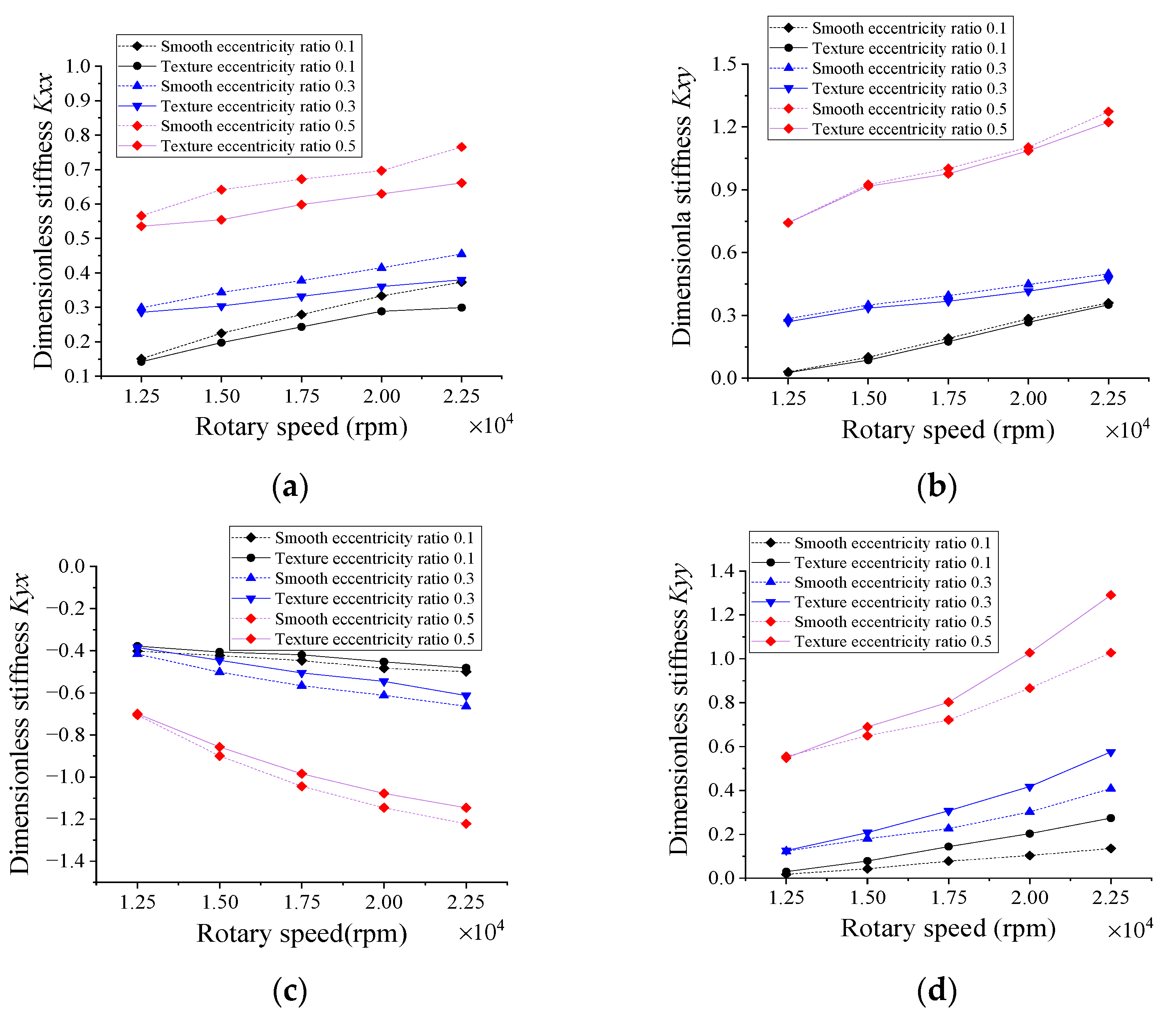
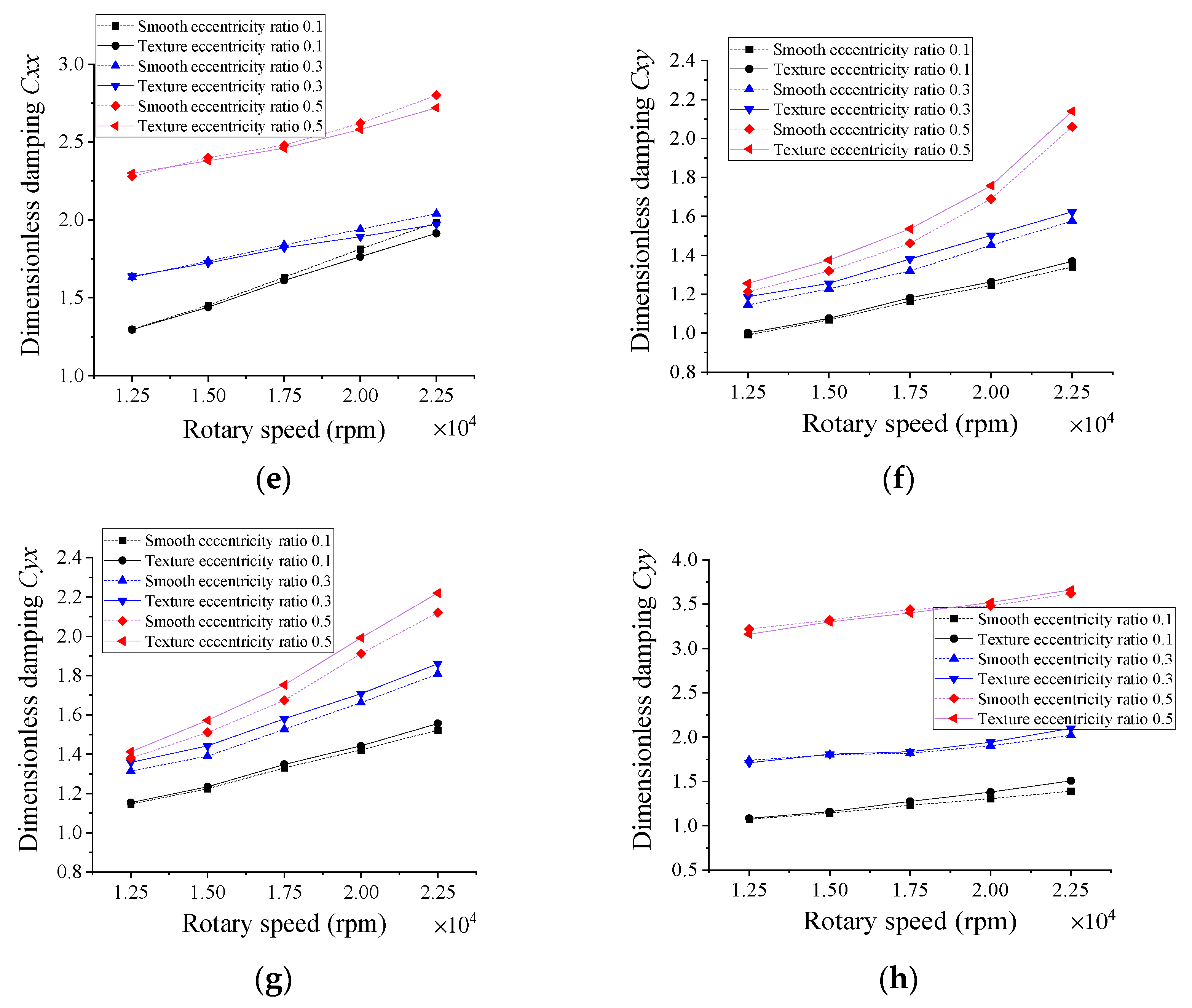
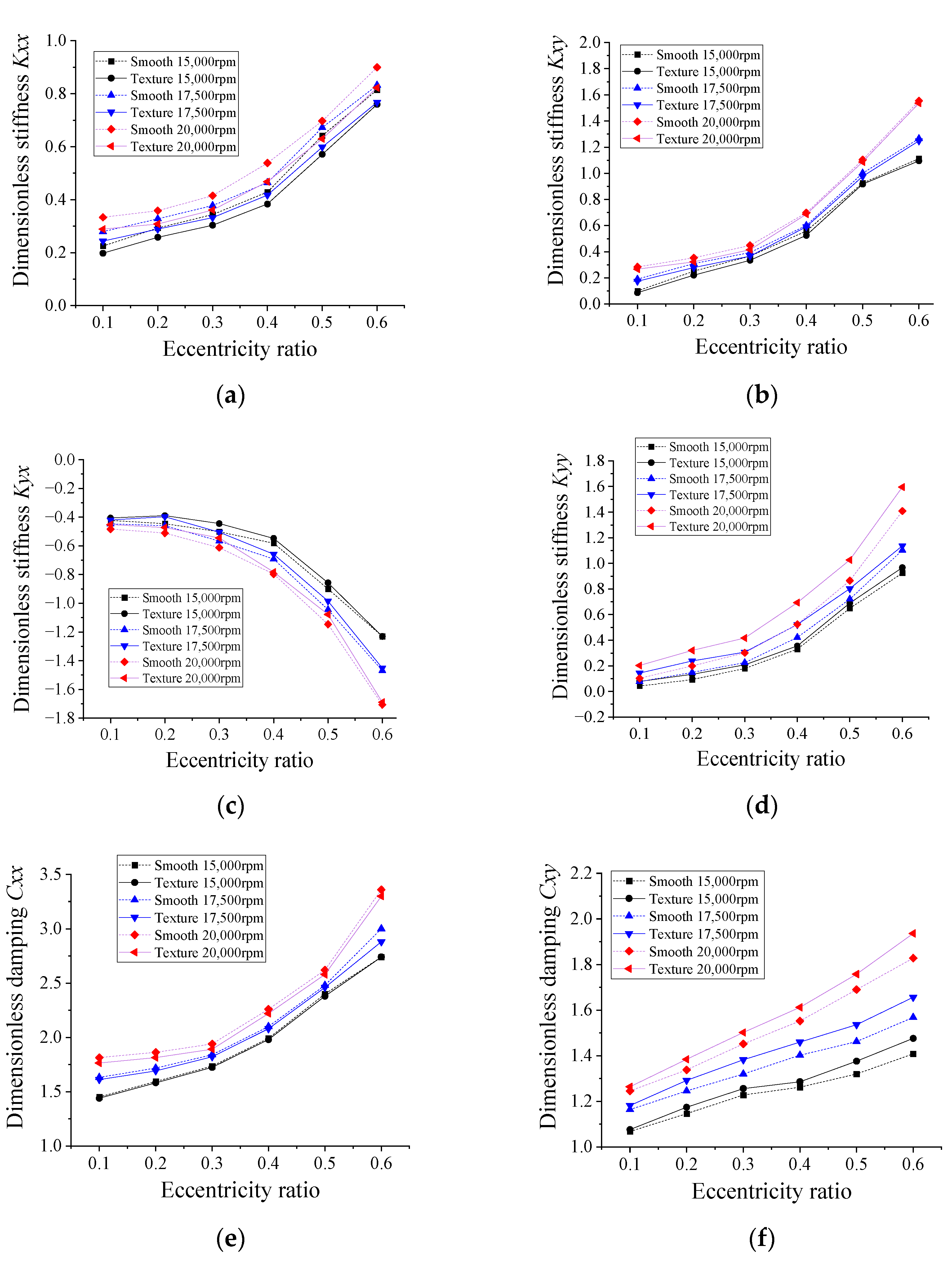
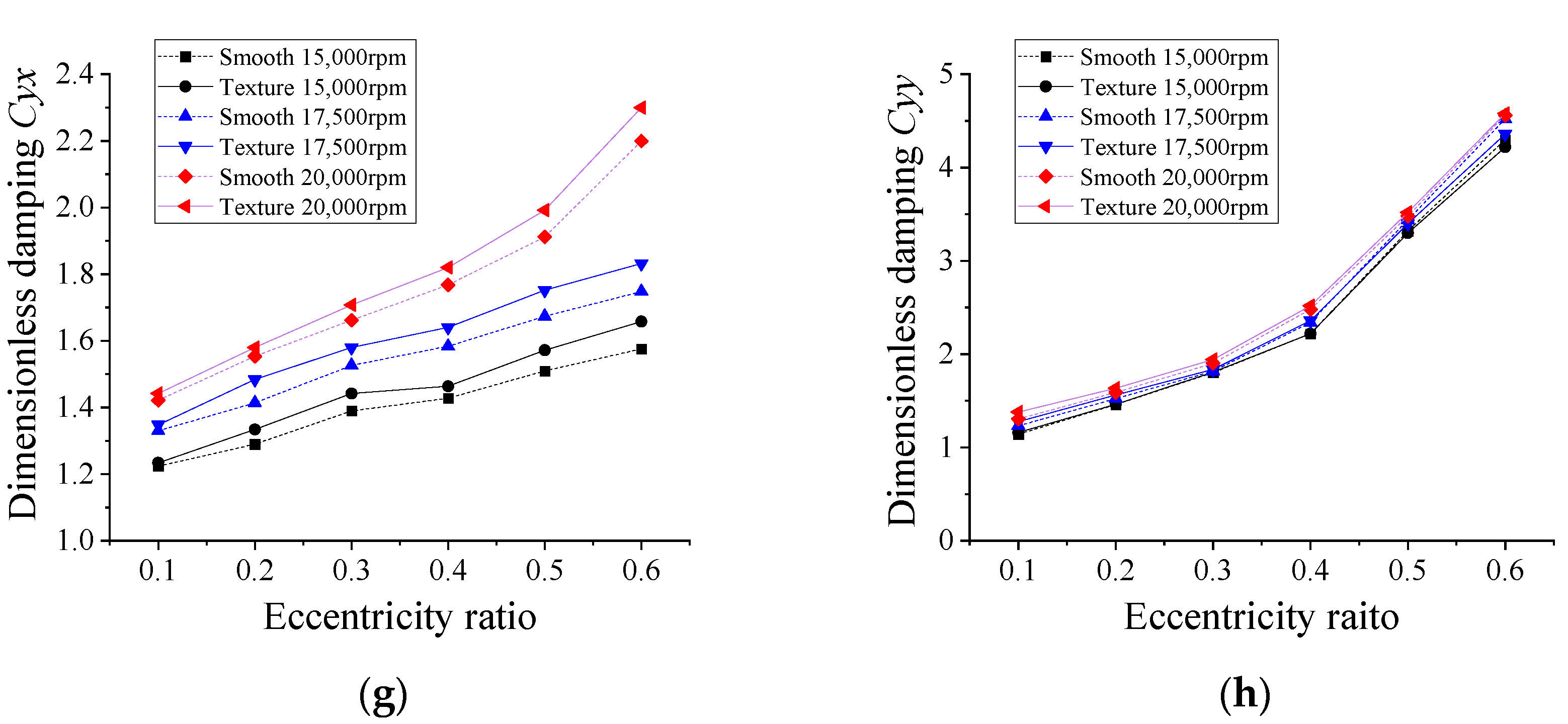

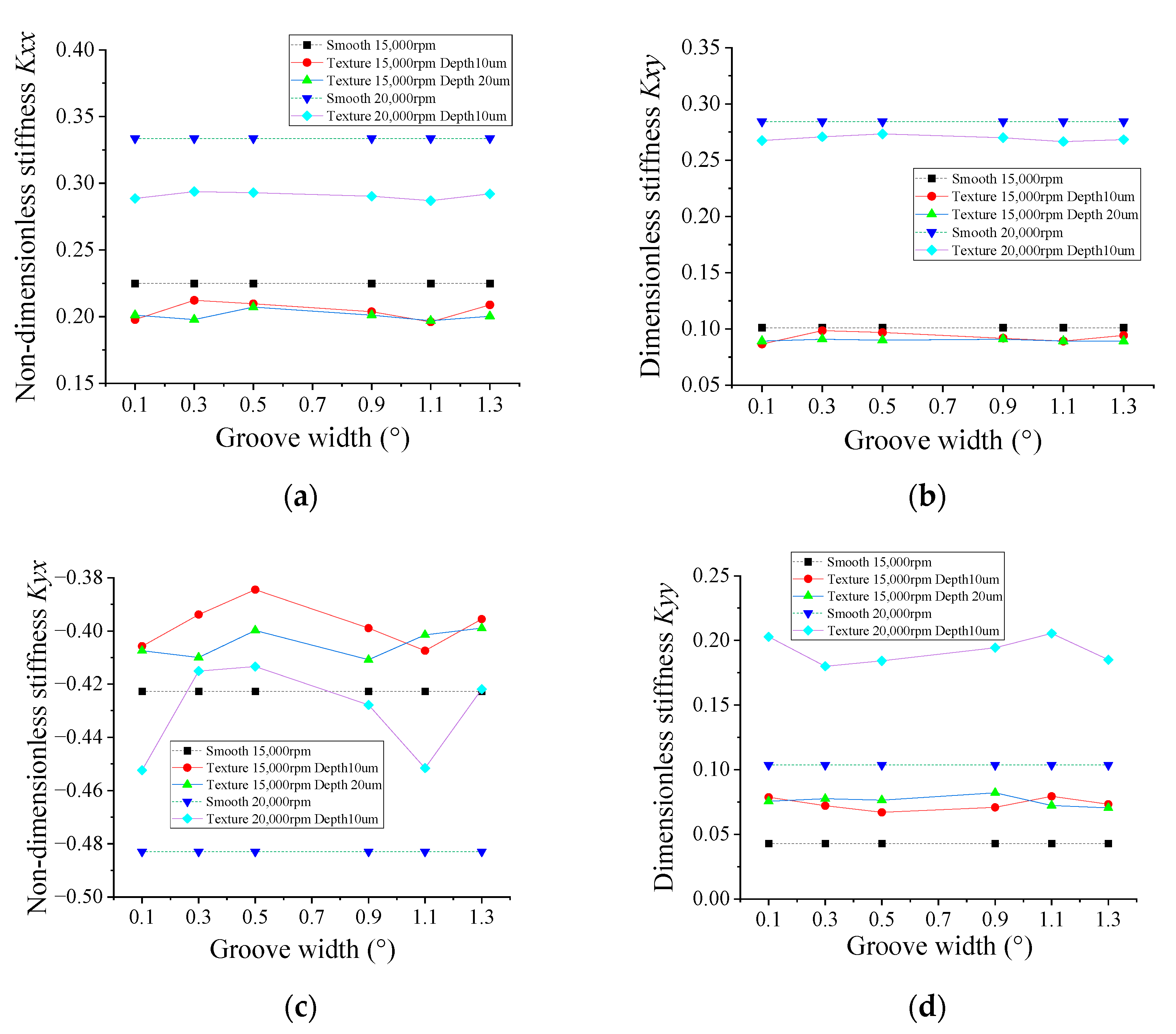
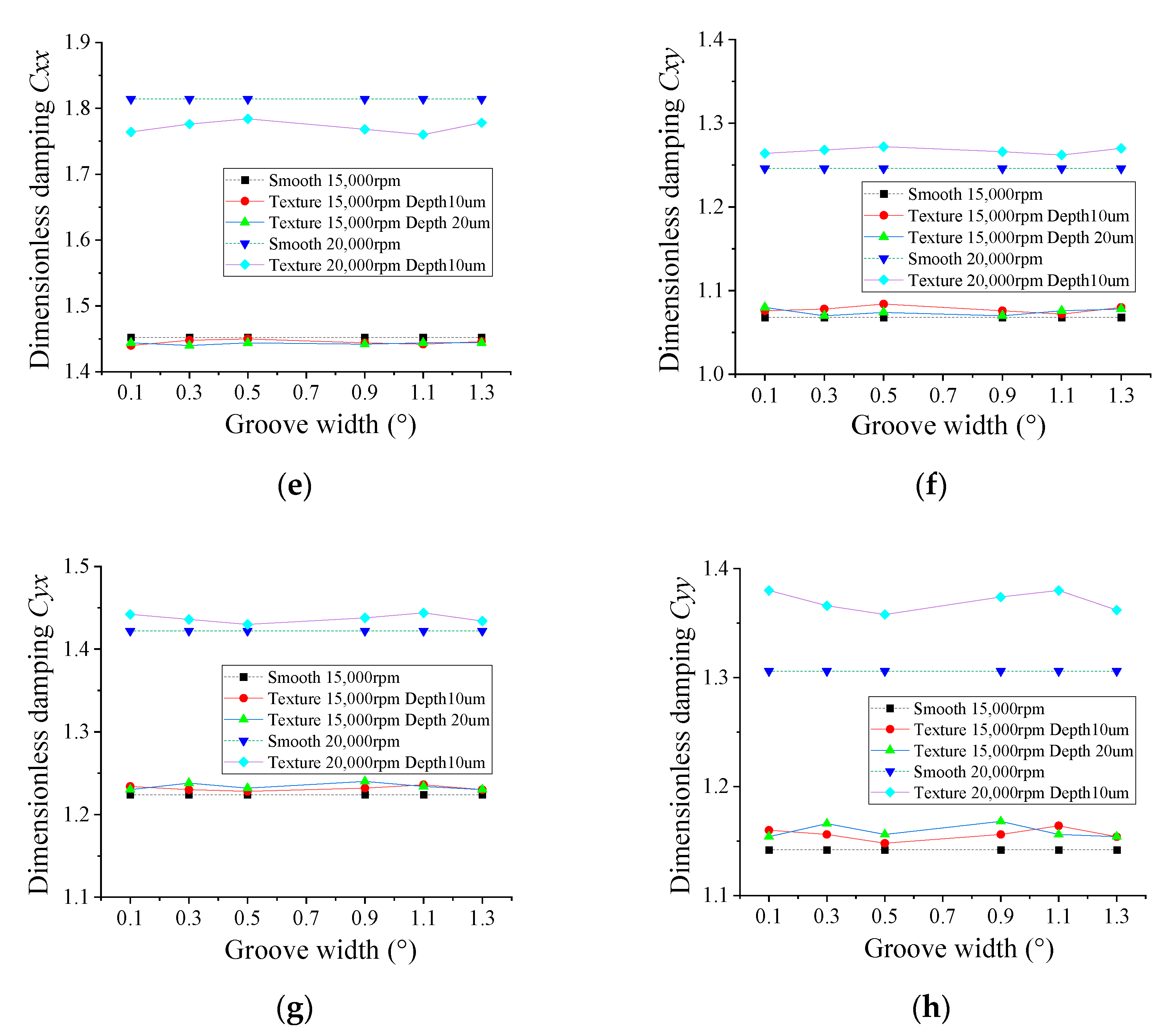
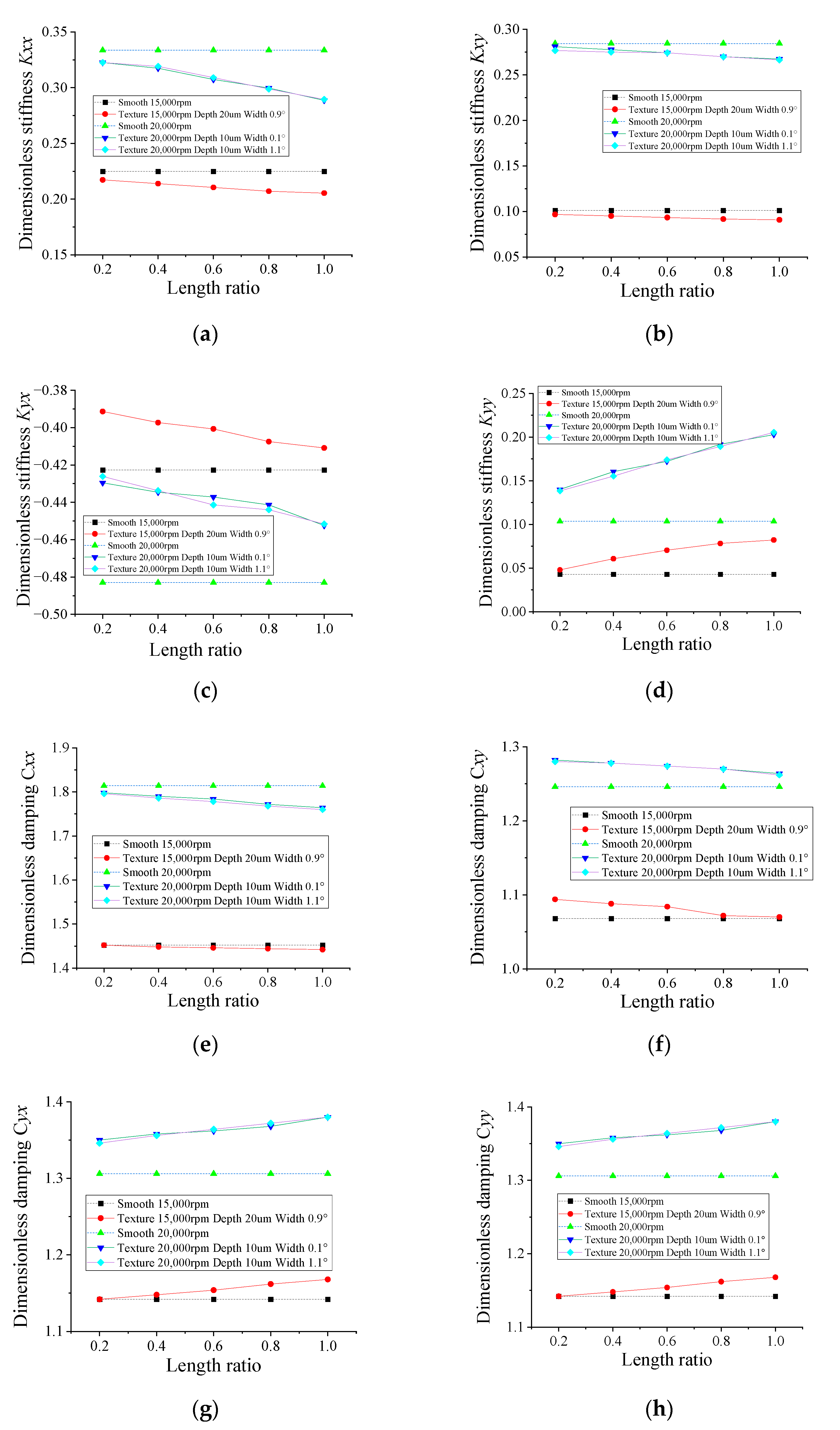
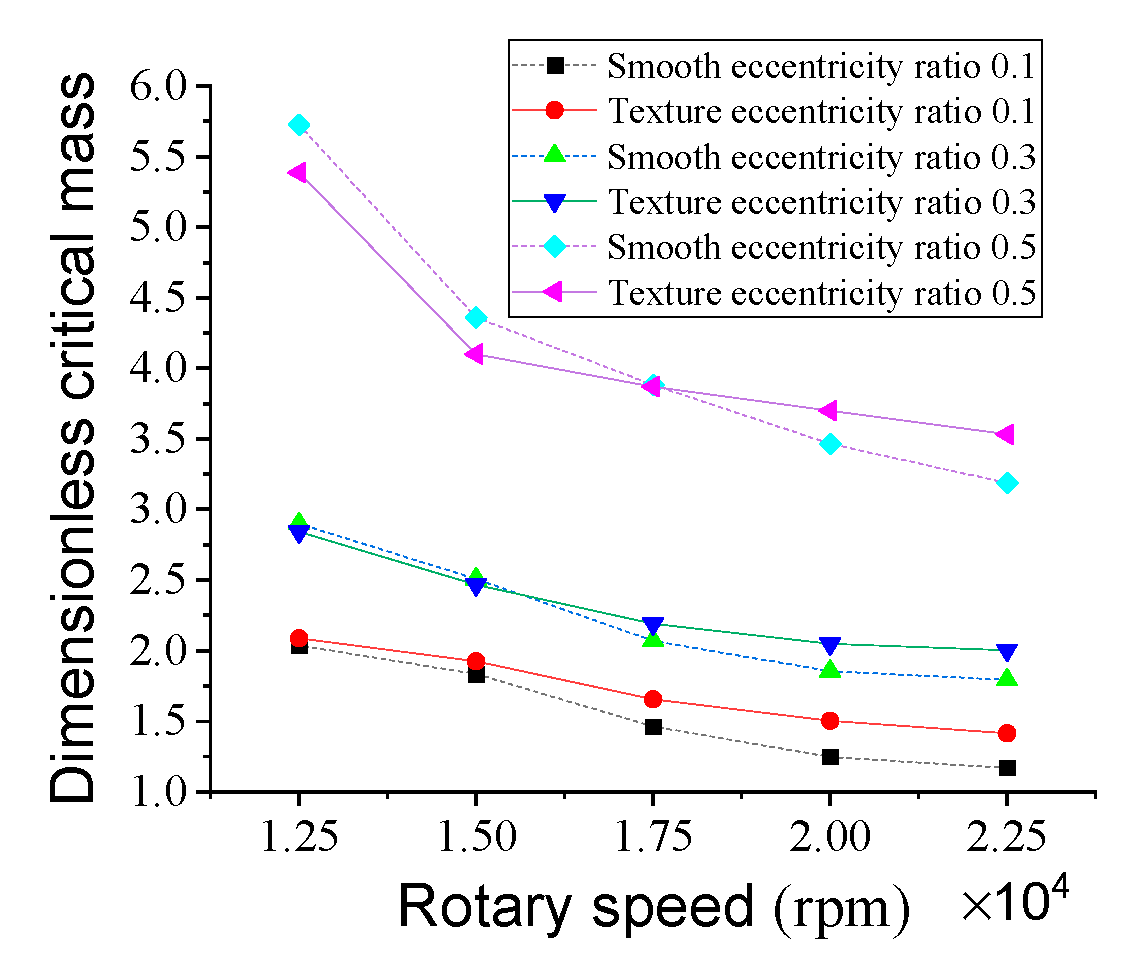
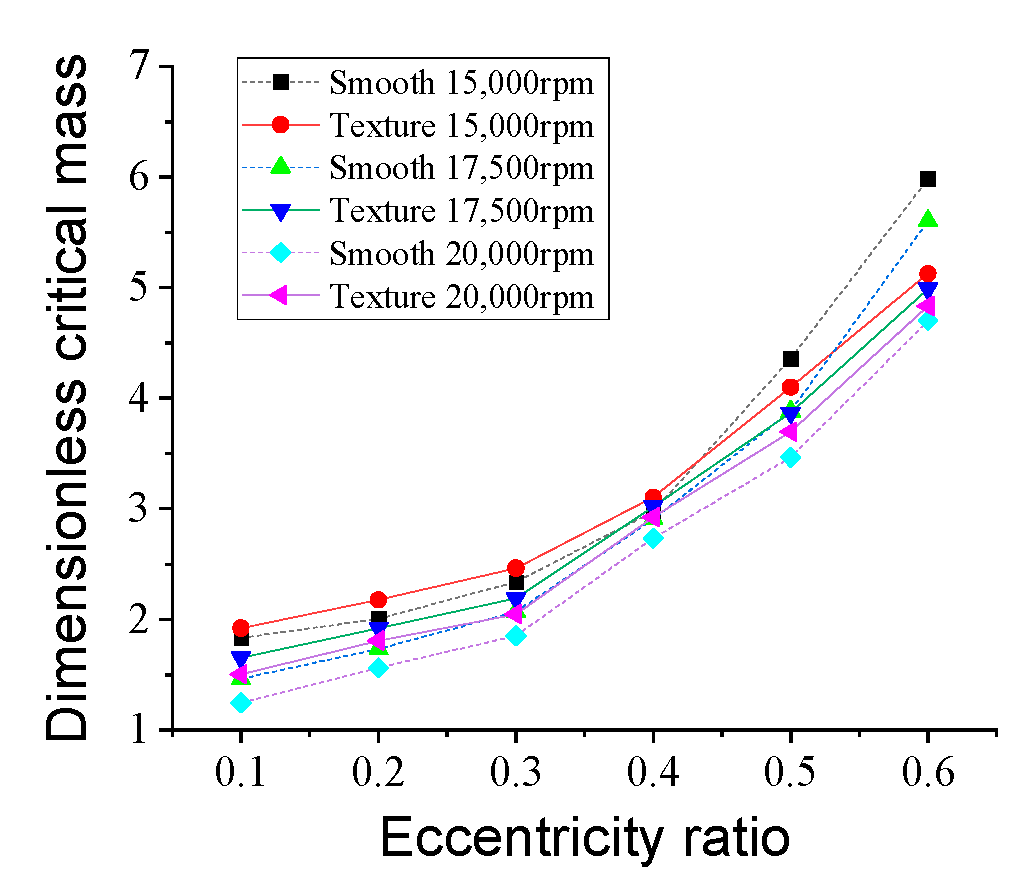
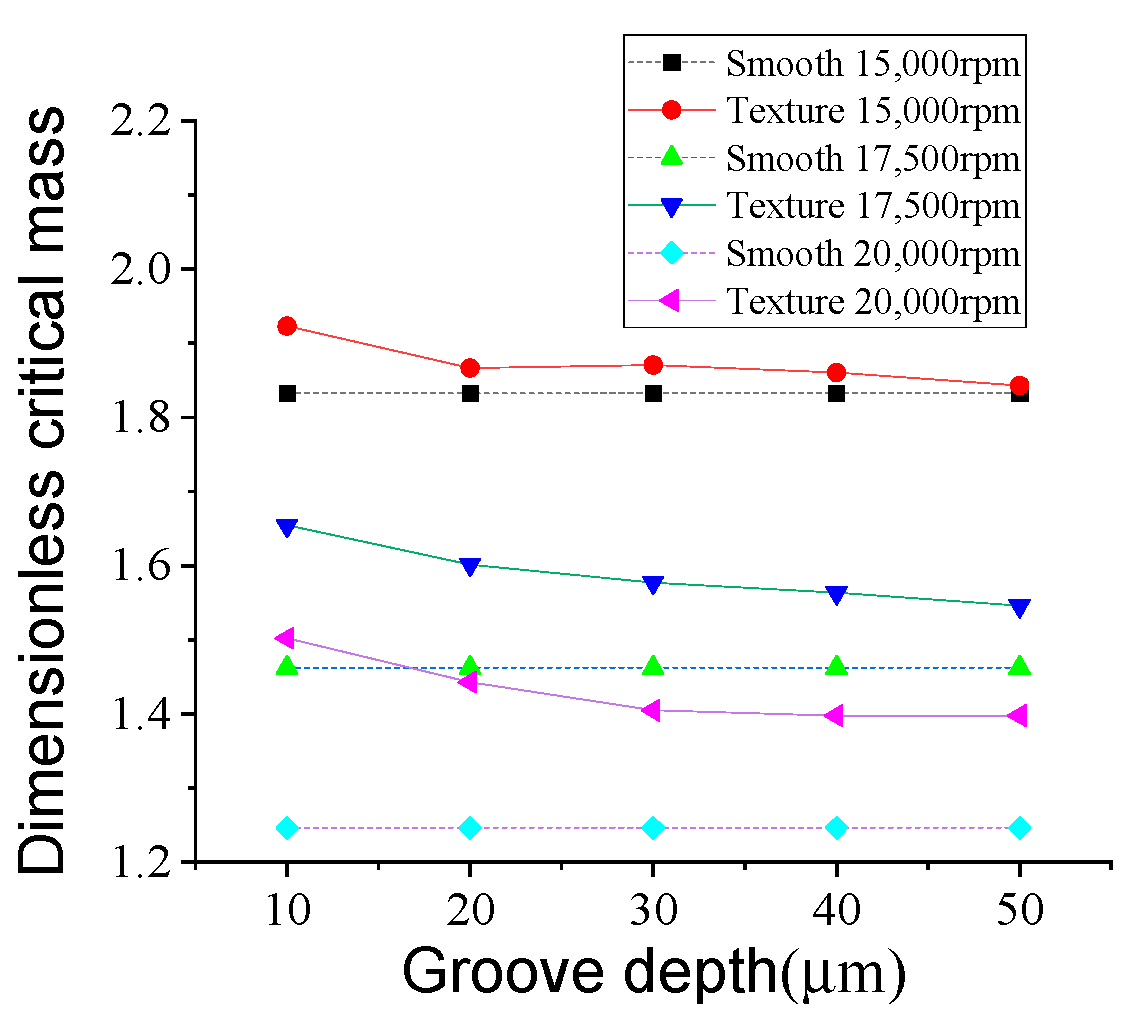
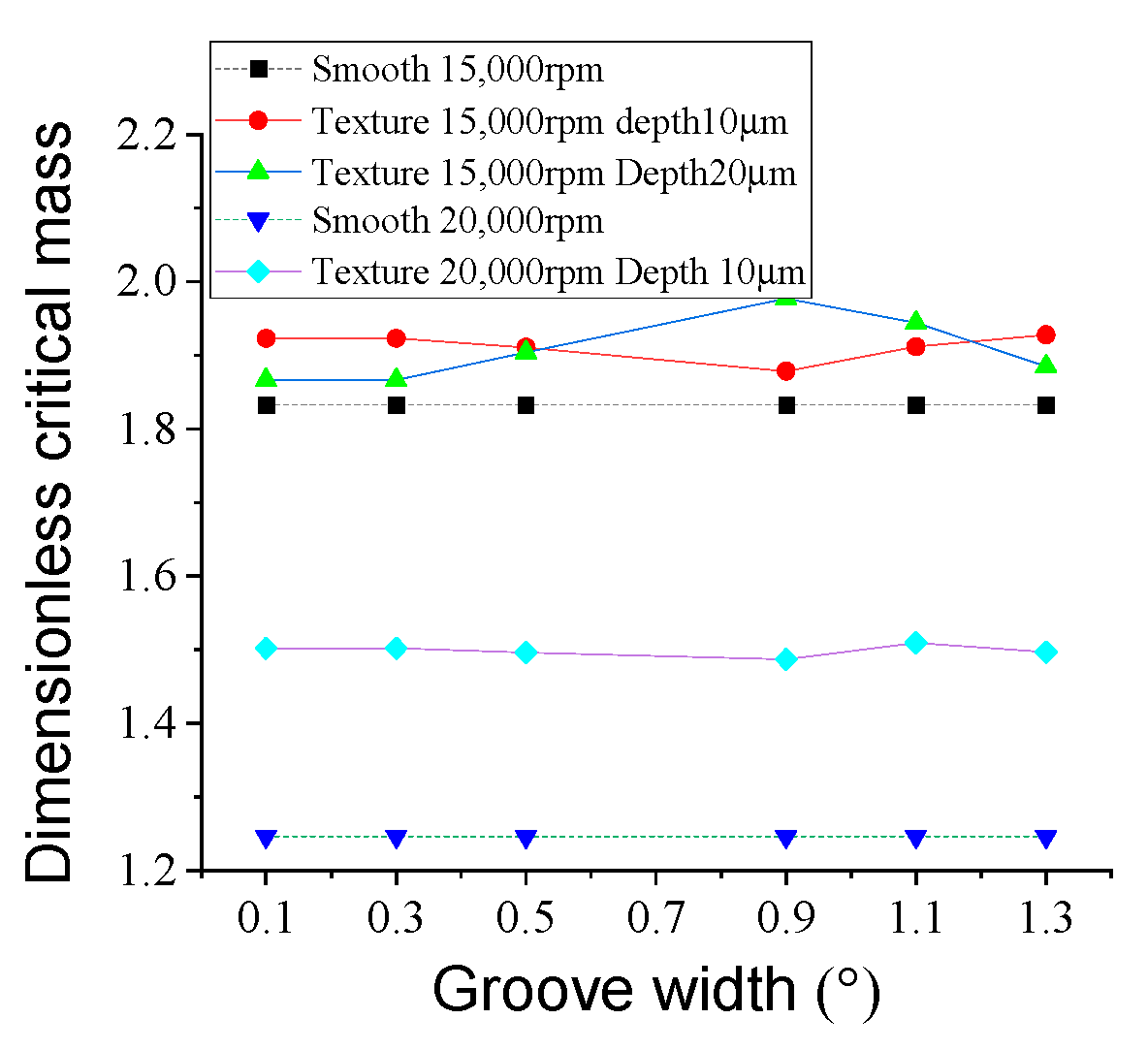

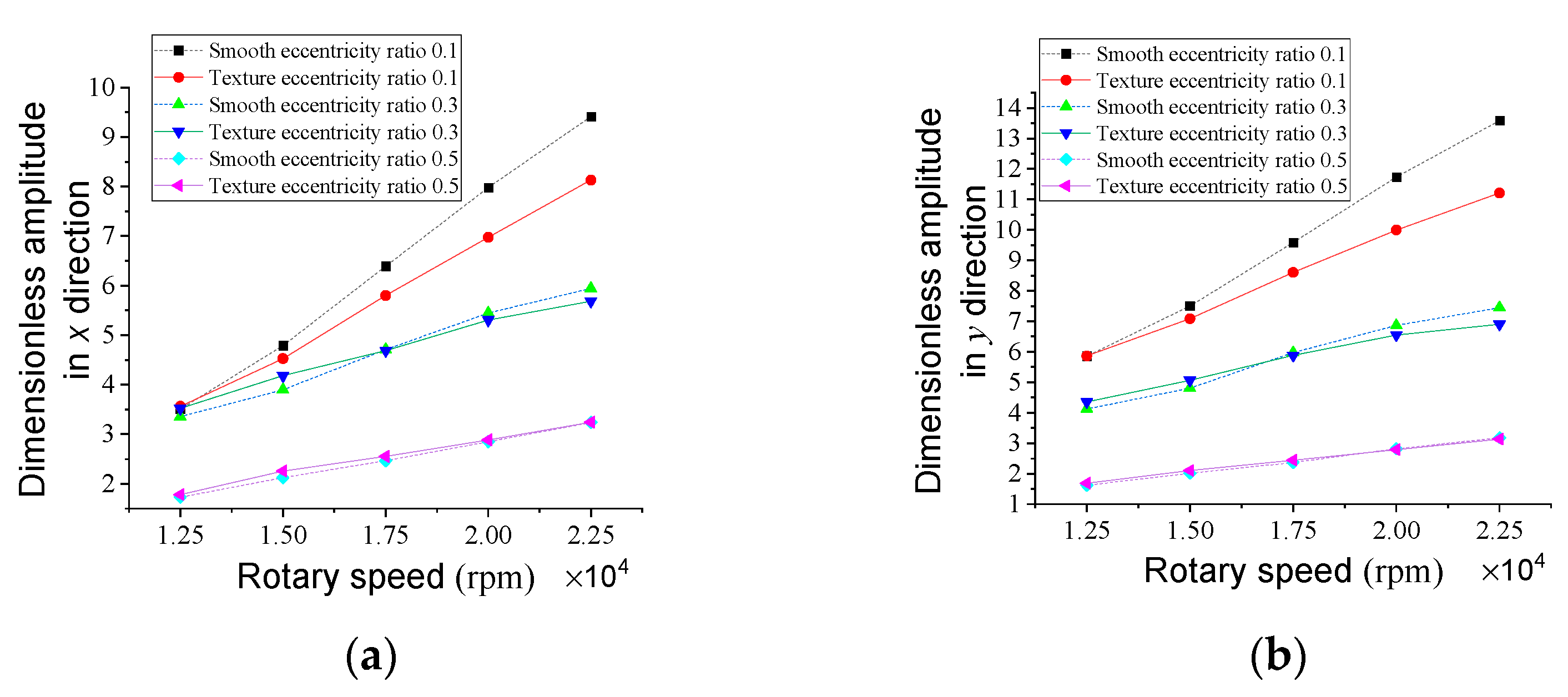
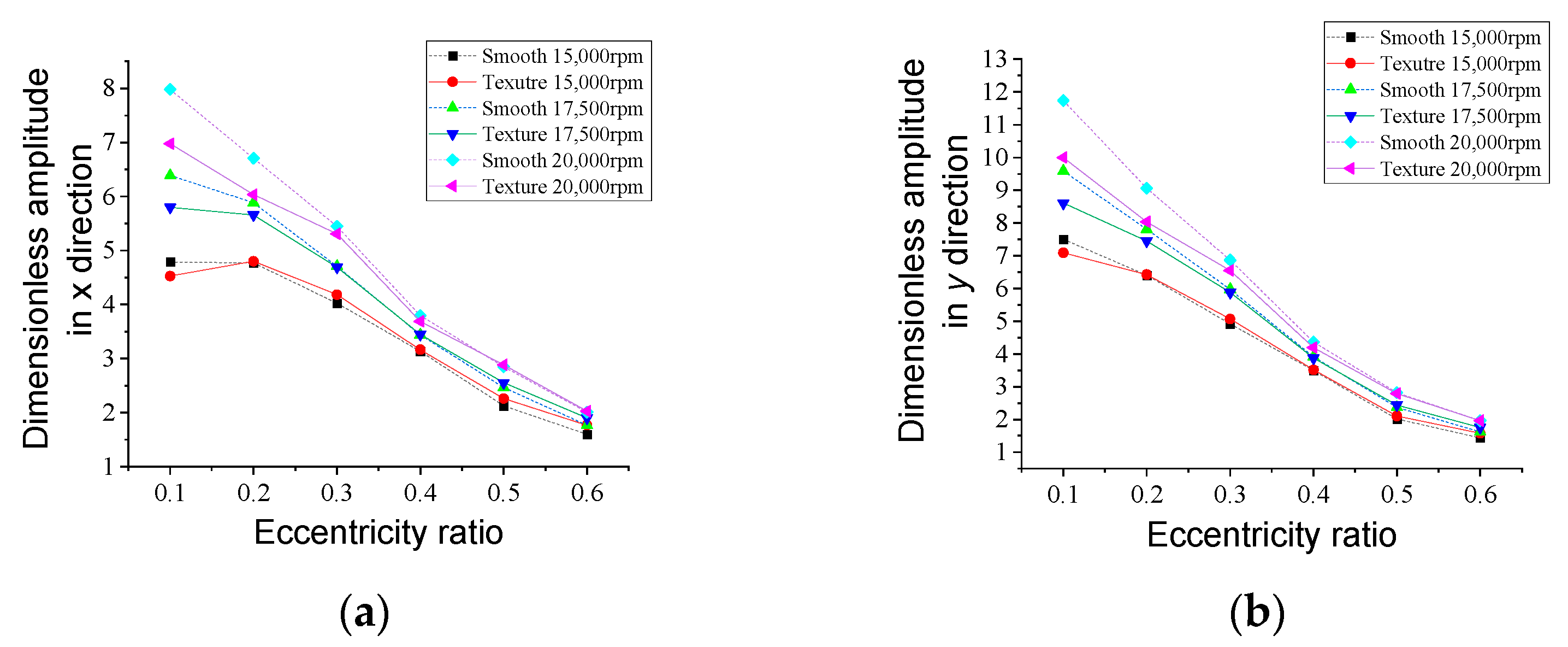

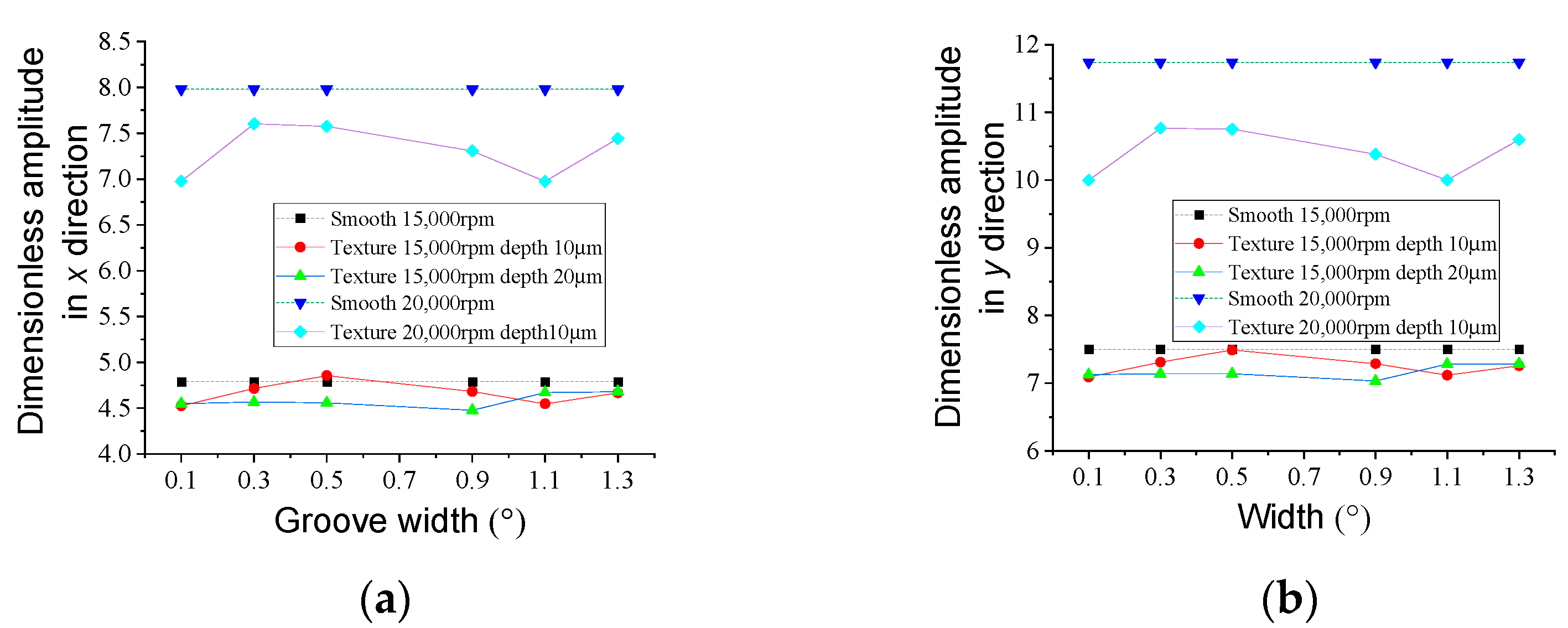
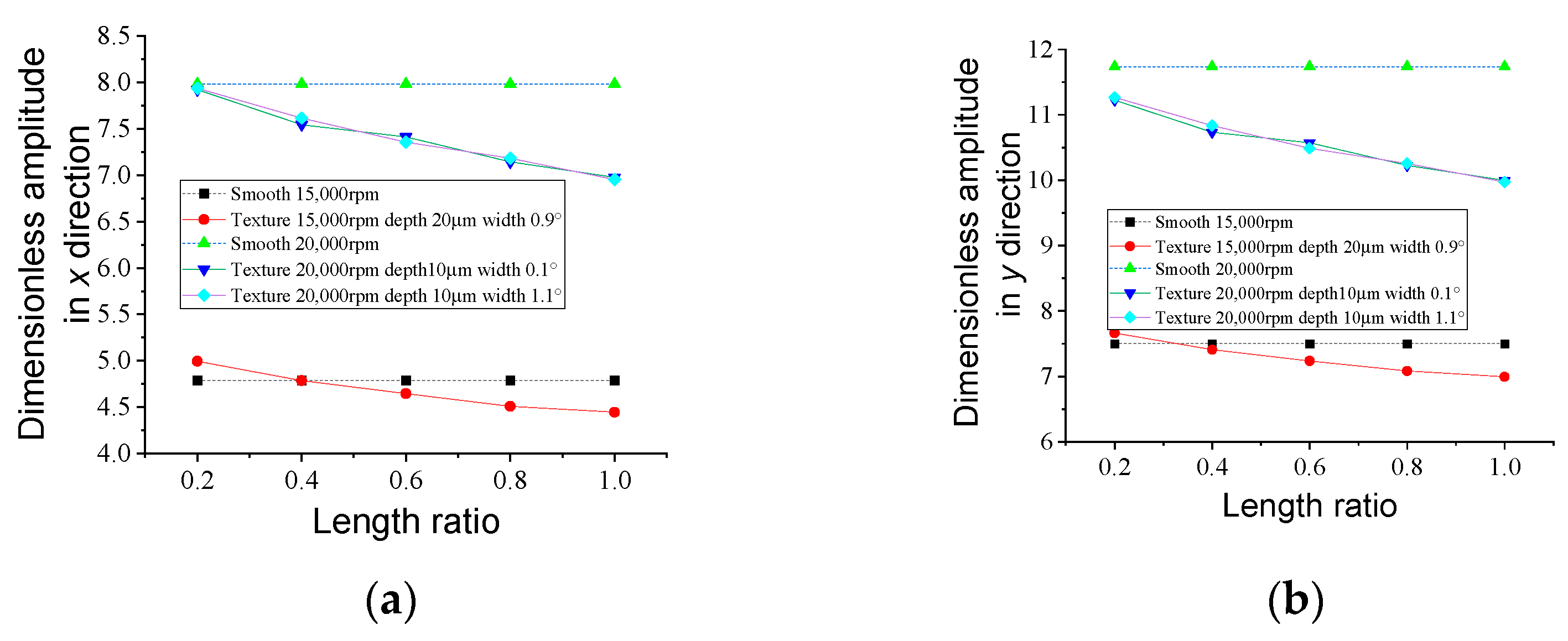
| Item | Value |
|---|---|
| Radial clearance h0 (um) | 50 |
| Diameter D (mm) | 50 |
| Length L (mm) | 50 |
| Groove width (°) | 0.1 |
| Groove depth (μm) | 10 |
| Groove length (mm) | 50 |
Disclaimer/Publisher’s Note: The statements, opinions and data contained in all publications are solely those of the individual author(s) and contributor(s) and not of MDPI and/or the editor(s). MDPI and/or the editor(s) disclaim responsibility for any injury to people or property resulting from any ideas, methods, instructions or products referred to in the content. |
© 2023 by the authors. Licensee MDPI, Basel, Switzerland. This article is an open access article distributed under the terms and conditions of the Creative Commons Attribution (CC BY) license (https://creativecommons.org/licenses/by/4.0/).
Share and Cite
Feng, H.; Gao, Z.; Van Ostayen, R.A.J.; Zhang, X. A Numerical Investigation of the Effects of Groove Texture on the Dynamics of a Water-Lubricated Bearing–Rotor System. Lubricants 2023, 11, 242. https://doi.org/10.3390/lubricants11060242
Feng H, Gao Z, Van Ostayen RAJ, Zhang X. A Numerical Investigation of the Effects of Groove Texture on the Dynamics of a Water-Lubricated Bearing–Rotor System. Lubricants. 2023; 11(6):242. https://doi.org/10.3390/lubricants11060242
Chicago/Turabian StyleFeng, Huihui, Zhiwei Gao, Ron. A. J. Van Ostayen, and Xiaofeng Zhang. 2023. "A Numerical Investigation of the Effects of Groove Texture on the Dynamics of a Water-Lubricated Bearing–Rotor System" Lubricants 11, no. 6: 242. https://doi.org/10.3390/lubricants11060242
APA StyleFeng, H., Gao, Z., Van Ostayen, R. A. J., & Zhang, X. (2023). A Numerical Investigation of the Effects of Groove Texture on the Dynamics of a Water-Lubricated Bearing–Rotor System. Lubricants, 11(6), 242. https://doi.org/10.3390/lubricants11060242





